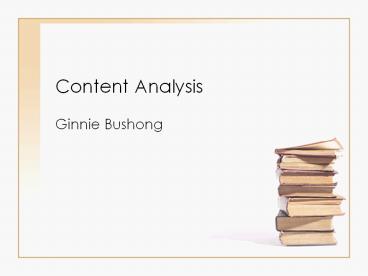Content Analysis - PowerPoint PPT Presentation
Title:
Content Analysis
Description:
Describe when it is appropriate to use content analysis. List the steps involved ... in content analysis research. ... Educational Research ... – PowerPoint PPT presentation
Number of Views:53
Avg rating:3.0/5.0
Title: Content Analysis
1
Content Analysis
- Ginnie Bushong
2
Objectives
- Define content analysis.
- Describe when it is appropriate to use content
analysis. - List the steps involved in content analysis.
- Describe the importance of categorization in
content analysis. - Describe the two major coding categories.
- Identify how reliability and validity is
established in content analysis research. - Describe how data is analyzed in content analysis
research. - Identify two major advantages and disadvantages
of content analysis. - Examine a journal article written about research
that uses content analysis.
3
Define content analysis
- Analysis of the contents of communication.
- Technique that allows us to study human behavior
indirectly through analyzing communications. - Textbooks, Newspapers, Essays, Magazines,
Articles, Cookbooks, Songs, Political Speeches,
Novels, Advertisements, and Pictures.
4
Appropriate use
- Educational Research
- Problem Insight
- Reasons
- Obtain descriptive information
- Analyze observable/interview data
- Test hypothesis
- Check other research findings
5
Example
- Counting the number of times that the words dog,
pickup truck, and broken heart occur in the
number one country songs for the past year. - Identify student activities on homecoming weekend
using Facebook.
6
Steps
- Develop rational
- Define important terms
- Determine method of sampling
- Determine unit of analysis
- Formulate coding categories
- Analyze data
- Conclude Report
7
Importance of categorization
- All studies must convert (code) descriptive
information into categories - Researcher determines categories before analysis
begins. - Researcher becomes familiar with the descriptive
information collected and allows the categories
to emerge as analysis continues.
8
Major coding categories
- Manifest
- Refers to the specific, clear, surface contents
words, pictures, images, and such that are easily
categorized. - Latent
- Refers to the meaning underlying what is
contained in a communication. - Both
- Combination.
9
Reliability and Validity
- Reliability
- Commonly checked by comparing the results of two
independent scorers. - Validity
- Commonly checked by comparing data obtained from
manifest content to that obtained from latent
content.
10
Data Analysis
- Frequencies
- Proportions of an specific occurrence to a total
occurrences. - Themes
- Computer Analysis
11
Advantages Disadvantages
- Advantages
- Unobtrusive
- Easy
- Disadvantages
- Limited to analysis of communications
- Difficult to establish validity
12
Journal Article
- Implications of Performance Measures and
Standards for Evaluation and Assessment in
Agricultural Education - Prolific Authors in the Journal of Agricultural
Education A Review of the Eighties - An Examination of Selected Preservice
Agricultural Teacher Education Programs in the
United States
13
Objectives
- Define content analysis.
- Describe when it is appropriate to use content
analysis. - List the steps involved in content analysis.
- Describe the importance of categorization in
content analysis. - Describe the two major coding categories.
- Identify how reliability and validity is
established in content analysis research. - Describe how data is analyzed in content analysis
research. - Identify two major advantages and disadvantages
of content analysis. - Examine a journal article written about research
that uses content analysis.
14
References
- Frankel, J. R. Wallen, N. E. (2006). How to
design and evaluate research in education, sixth
edition. Boston McGraw Hill. - Journal of Agricultural Education































